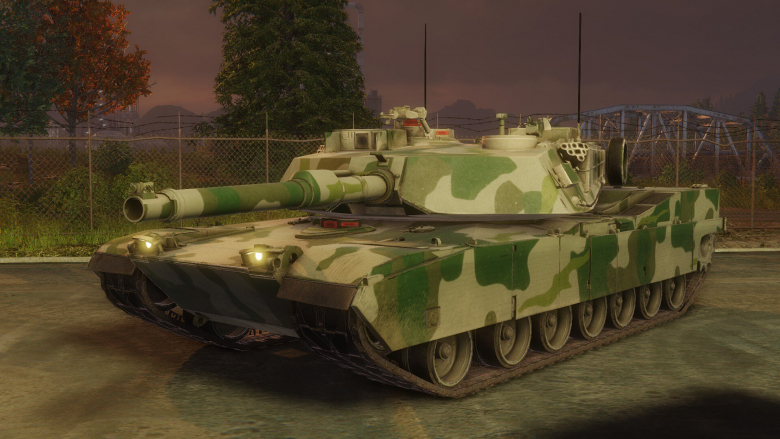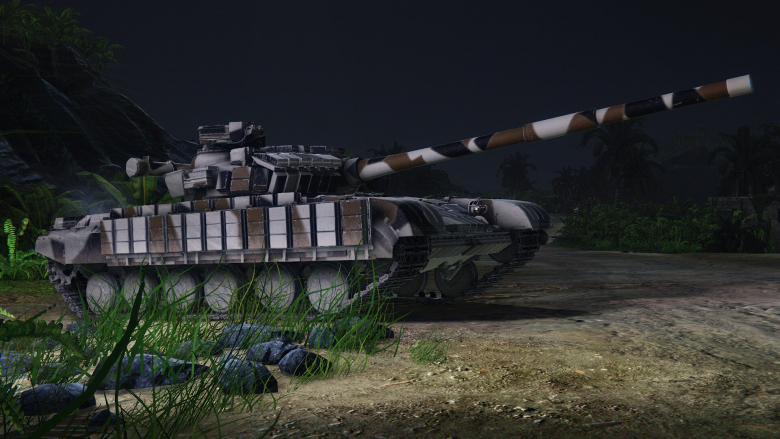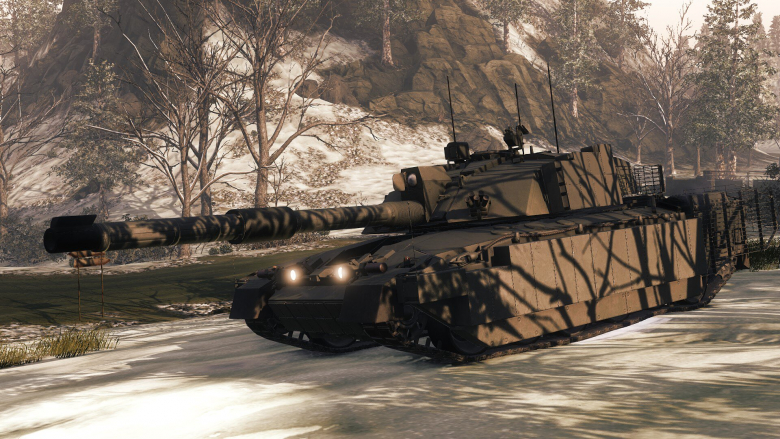
Main Battle Tanks are the ultimate evolution of the tank concept that started during the Great War and fully evolved during the Second World War. They are powerful, lumbering beasts that are capable of deciding a battle on their own. Even though the age of massive armored clashes is over, the Main Battle Tanks still have a role on the modern battlefield.

Main Battle Tanks are the most popular class of Armored Warfare. There are two reasons for that. First, they are versatile and generally accessible to new players. They don’t carry as much firepower as the Tank Destroyers, nor are they as fast as the Light Tank or the AFVs, but they also don’t have any massive drawbacks save for some very specific cases.
Secondly, they have something most other vehicle classes don’t – thick armor. While other classes can, thanks to their active defenses and various upgrades, become quite resistant to certain type of shells, only the Main Battle Tanks consistently offer protection against practically all threats on the battlefield. Experienced players can use other, more specialized, classes to their maximum effect, but this versatility allows even new players to keep up.
The MBT class is perhaps the most diverse class in the entire game. It includes a wide variety of vehicles that range from very light members of the class whose mobility is only slightly worse than that of the AFVs and LTs (at the expense of armor that is inferior to their heavier counterparts) to massive lumbering behemoths that may be the slowest tanks in the game, but that can also shrug off almost any impact and only careful aiming at their weakspots or a risky flanking maneuver can damage them or knock them out. There are a few things they all have in common:
- Firepower inferior to Tank Destroyers
- Gun stabilization inferior to Light Tanks and Tank Destroyers
- Mobility inferior to Light Tanks and Armored Fighting Vehicles
- Poor camouflage rating
When it comes to the stabilization parameter, what this means is that both the Light Tanks and the Tank Destroyers can fire more accurately on the move. While this may be a bit counterintuitive (in real life, the Main Battle Tanks have very advanced gun stabilization systems), it allows the other classes to find their roles on the battlefield without having the MBTs be simply the best in every single role – after all, in real life, vehicle cost plays a significant role in any tactical considerations while in the game it does not.
The last point is especially important – Main Battle Tanks are large, noisy and conspicuous. They don’t hide very well even behind multiple camouflage-providing bushes and will always be outmatched by other classes in this respect. They also become the primary targets on the battlefield as they generally can easily break enemy lines or lead the charges of lighter vehicles, acting as both inspiration and shield.
This last statement does, however, not count for all the vehicles of this class. Therefore, it’s worth looking at the various groups that are, for easier reference, divided by their country of origin.
Notable members:
- M48 Patton series
- M60 Patton series
- M1 Abrams series
- XM1A3 Abrams (Top Vehicle)
American tanks are the baseline of the Armored Warfare MBT class. They are the jack-of-all-trades of MBTs but also masters of none. Their armor is average and so is their firepower in the form of standard NATO tank 105mm rifled and 120mm smoothbore cannons. The iconic Abrams tanks offer solid protection and maneuverability but can be outgunned by the Leopards and outmaneuvered by the high-Tier Russian vehicles. They do not have any significant drawbacks, although the low-Tier vehicles (M48 and M60 series) lack composite armor (unlike the Soviets) and are therefore more vulnerable to HEAT rounds and guided missiles. The protection level only becomes good with the M1 Abrams. One outlier that’s worth mentioning is the M60A2 Starship, offering excellent firepower in the form of its 152mm cannon as well as the ability to fire guided missiles on its tier, but slow reload times and mediocre protection.

American generally use manually loaded guns – with full crew training, they can fire faster than automatically loaded guns, but with untrained crews they do lag behind. Due to this fact, the American vehicles have crews of four men.
The XM1A3 offers a unique choice between a powerful automatically loaded 120mm M256 FASTDRAW cannon (2 shots in quick succession) and a 140mm cannon with high damage per shot and penetration but slower reload.
Firepower-wise, the American vehicles have several advantages over the other nationalities. For one, they have better gun stabilization than other MBT branches – in other words, they can fire more accurately on the move, regardless of whether they are turning or just going forward.
Secondly, unlike other MBTs, the American tanks (specifically the Abrams series) generally lack High-Explosive ammunition and gun-launched missiles. This can be a downside during certain situation, but the high-Tier Abrams tanks have a special type of ammunition instead – the HEAT-MP, a round that works both like a HEAT and a HE round (starting from Update 0.22, both effects are correctly applied).
The American MBTs are ideal for you if you are still deciding what play style you prefer or are a new player. They are quite forgiving to mistakes and at the same time capable of excellent results, although experienced players will ultimately perform better in specialized vehicles.
Notable members:
- T-64
- T-72 series
- T-80 series
- T-90 series
- T-14 Armata (Top Vehicle)
The Soviet and Russian tanks are the brawlers of Armored Warfare MBT class. While not extremely accurate, they are quite mobile even though their armor is only average. What they excel in is close-range fighting and damage per minute values – all their guns starting from the T-64 and the T-72 Ural are automatically loaded and can reach their full rate of fire without additional required crew training. They use almost exclusively 125mm guns that, especially at lower Tiers, deal massive damage per shot as well and are some of the most powerful weapons in the game until the appearance of the NATO 120mm smoothbore. Additionally, unlike the American tanks, the Russian tanks can fire both HE ammunition and gun-launched guided missiles that, while slow and thwarted by APS, can deliver devastating hits if used properly.

On the downside, they only have three crew members, making their choice of crew perks limited (this will become even more important in the upcoming Crew system overhaul).
They generally have low silhouettes and small sizes – as a result, they do tend to hide better than their larger counterparts, but they also generally have fewer hitpoints and the guns also generally have poor depression due to their low turrets.
Armor-wise, the frontal protection is generally excellent with composite armor and ERA appearing even on low Tiers, but their side armor is usually extremely weak and easy to penetrate.
The T-14 Armata is the ultimate damage-per-minute MBT in the game, capable of dishing out incredible damage over longer time periods. It also has an unmanned turret that only takes reduced damage. On the downside, it’s not the best armored tank around and the turret is not that hard to penetrate. The long 125mm gun, while powerful, is not the most accurate weapon around and requires some careful aiming.
The Russian and Soviet MBTs are ideal for you if you prefer aggressive gameplay, to fight at medium to short distances and to take the fight to the enemy. They can easily lead the charge and are harder to hit thanks to their small size and excellent frontal sloped armor, but are quite unsuitable for defensive operations due to their poor gun depression and low reverse speed that does not allow them to retreat from danger effectively.
Notable members:
- Leopard 1 series (including the Italian OF-40)
- Leopard 2 series
- Leopard 2AX (Top Vehicle)
The German MBTs are the polar opposite of the Soviet vehicles. They are the snipers of the MBT class, perfectly suited for defensive warfare but outmatched at close range by their opponents. They are the most accurate MBTs of Armored Warfare and their tactic of choice should always be to keep their enemies as far from them as possible.
They consist of two distinctive vehicle families – the Leopard 1 series and the Leopard 2 series. The Leopard 1 tanks are fast but extremely fragile tanks with poor steel armor and few defensive measures. They are amongst the most fragile MBTs in the game, but their agility and speed puts them closer to the Light Tank class. They require some careful gameplay to make them effective.

The Leopard 2 tanks are very accurate, but can’t really brawl as well as the Americans or the Russians. In real life, these were built as purely defensive weapons, their intended tactic was to stay in cover, fire, achieve as many kills as possible with their first shot and then retreat away. That is how they are intended to be played in Armored Warfare, although they are also, if needed, capable of leading charges – their powerful armor still protects them against many threats. They are not, however, very agile and their turrets are slow to traverse, making engaging nimble targets at short distances difficult.
Like the Americans, the German guns are manually loaded (in real life, the Germans consider automatic loaders to be too unreliable) and they have four crewmembers, giving them access to more crew skills and – when fully trained – to solid rate of fire.
The Tier 10 Leopard 2AX plays much like the rest of the Leopard 2 series. Its ultimate weapon is the Rheinmetall 130mm gun – a unique caliber no other tank has. This weapon is extremely accurate, reflecting the whole nature of this vehicle. Furthermore, the German HEAT and kinetic rounds usually have the best penetration values in the game, reflecting the requirement to be fired at long distances.
The late German tanks are ideal for you if you prefer to snipe but also want to keep some armor without having to rely on stealth. If forced to advance, cover your hull, drive from cover to cover and use terrain to your advantage.
Notable members:
- Chieftain series
- Challenger series
- Challenger 2 ATDU (Top Vehicle)
Where the Americans are jacks-of-all-trades, the Russians are brawlers and the Germans are snipers, the British vehicles rely on two things – HESH ammunition and armor. The British MBTs are invariably slow and sluggish and are better at taking punches than avoiding them. The low-Tier Chieftains offer solid turret protection but their hulls are generally vulnerable. The Challengers, however, are a different story entirely – they can resist many types of shells and while they do have a number of weakspots, their thick hide routinely saves them even in the thickest fighting and allows them to survive scraps that would leave other tanks smoking wrecks.

As the only nation that stuck to the 120mm rifled guns, the British have special access to ammunition that tears even the thickest armor apart – the High-Explosive Squash Head rounds. This ammunition was developed to defeat Soviet tanks with sloped armor and is brutally effective against well-angled frontal plates typical for Russian designscomposite armor plates. This allows the Chieftains and Challengers to fight off their Russian counterparts comfortably despite their mediocre mobility.
While having a tough hide might seem like a no-brainer for successful gameplay, the mediocre mobility and generally poor firepower of the 120mm rifled guns make the British vehicles more suitable for experienced players. The British MBTs are not suited for fast maneuvering and have to rely on some elementary player coordination to succeed – even though they are able to mount spirited and unyielding defense, without support they will eventually get outflanked and overrun.
Notable members:
- Type 59 variants
- Modern Chinese MBTs like the Type 99
- Type 99A2
The Chinese vehicles are somewhat specific by the fact that China caught up with the whole tanks arms race relatively late. As such, the low-Tier vehicles use generally obsolete platforms with better technology. Gameplay-wise, low-to-mid Tier vehicles behave like Russian tanks, but with more focus on single shot damage at the expense of mobility. These tanks are generally sluggish and not well-protected, but pack quite a punch.

Higher Tiers are a different story entirely. Starting from Tier 5, the Chinese vehicles gradually become more agile. Please note, however, that agility does not imply mobility – the Chinese tanks can traverse their hull rather quickly, but are nowhere near as fast as other tanks of their Tier, nor do they accelerate quickly.
Tier 5 and higher also start featuring new composite armor turrets and other advanced equipment such as the JD-3 APS system. The highest Tiers, coming in Update 0.22, will also add thick armor to the equation, although the vehicles will focus on more damage per minute. The top weapon of the Chinese branch will be the long L/55 125mm cannon, developed as an upgrade to the standard 125mm ZPT-98 series of the Type 96 and Type 99 MBTs.
Gameplay-wise, the Chinese Main Battle Tanks are somewhere between the Russian tanks and the Leopard 2 series. They are excellent support weapons but other MBTs are more suitable for both defense and leading the charge. As such, they are more suitable for advanced players, as they require certain battlefield flow prediction.
Main Battle Tank Battlefield Role
The Main Battle Tanks are the center points of each team. The team tactics revolve around them and their capabilities due to their unique ability to charge forward and soak up damage thanks to their thick armor. MBTs are made to lead both attacks and stubborn defenses. That is not to say that they are invulnerable or that they can decide battles on their own. They can generally be outflanked and have to in many cases rely on support of other classes.
Main Battle Tanks should favor areas that don’t allow the enemies to easily flank them, such as:
- Mountain passes
- Valleys with tall sides
- Cities and other urban areas
In such environments, the MBT class can use its main advantage – thick frontal armor that should always be positioned towards the most dangerous enemy or towards potential threats.






